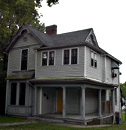|

1904 Washington Ave.
1,850 sq. ft. (approx)
Two 2-bdrm units
Contact: Chuck Green
Pinnacle Real Estate
694-4494
Comment
on this story
|
 |

by Matt Edens
For most investors, inner-city real estate is a little like farming: Cheap, rundown houses are the fields, and desperate, low-income tenants are the seeds. Put one into the other, and you can reap quite a cash crop (and, like most forms of modern American agriculture, there's a surprising amount of government subsidy involved).
It's a cash business—an advantage when you're acquiring property via estate auctions, tax sales and foreclosures (farming poverty works best in those parts of town the conventional real estate market has largely turned its back on). Pick up a house at auction for $20,000, spend another $15,000 on a quick and dirty rehab to convert it into a duplex (building permit? We don't need no stinking building permit...) and rent it through HUD's Section 8 voucher program for three years, and you've covered your investment (HUD's "Fair Market Rent" for a two-bedroom unit in Knoxville is $505). After that, you'll be raking in over $12,000 in cash annually—minus insurance and property taxes (assuming you bother to pay them). You certainly don't spend anything on maintenance—that's for long-term investors looking to cash in on appreciation. You're playing a short-term game where the real estate itself is valueless, other than the cash you can squeeze out of it. Make it five or six years before a tenant or neighbor calls Codes Enforcement and, when that "Unfit For Human Habitation" sign goes up, simply walk away with a 100 percent profit. The house will get bulldozed and the lot left fallow, producing nothing but weeds. The center-city's littered with them, vacant lots that are the byproducts of slash and burn poverty farming, the insidious process that liquidates neighborhoods into cold, hard cash.
It doesn't have to work that way. There are plenty of opportunities for investors to realize a healthy return without destroying the neighborhood in the process. The City of Knoxville's Rental Rehab Program (215-2120) provides subsidies to landlords willing to invest in quality affordable housing. Then there are the income tax credits that allow investors to recover 20 percent of their rehab costs in historic districts (It's possible to combine the two.).
There are even ways to convert a potential piece of slumlord property into a decent home for your own family. Wells Fargo Bank, a sponsor of this column, has a loan program that allows you to combine purchase and renovation costs into a single loan and a single closing (a financial option that is available to investors as well). Or, if the idea of managing your own renovation project conjures up visions of The Money Pit, check with Knox Heritage. Thanks to a partnership with the National Trust, Knox Heritage can purchase, renovate and sell you your dream home in a turnkey transaction—sign a contract to purchase after rehab, and they'll do it all to your specifications. All you need to do is find the right house.
Might I suggest this one: 1904 Washington Avenue in Parkridge. Divided into a duplex, condemned and currently in foreclosure, it's fertile ground for the guys farming poverty for profit. But we're not going to let that happen, are we? Whether you're a would-be investor looking for a tax shelter or an aspiring homeowner with a weakness for Victorian architecture, this house might be just what you're looking for.
Not that it'll be easy. The interior trim—including the original staircase—and exterior gingerbread may be surprisingly intact, but the funky paneling and shagadelic carpeting are the least of this place's problems. It is condemned. And it'll take a serious renovation project—wiring, plumbing, heat and air—to put it back to rights. But the result would be something to be proud of.
Or it can eventually wind up an overgrown lot. It's your call.

September 18, 2003 * Vol. 13, No. 38
© 2003 Metro Pulse
|





